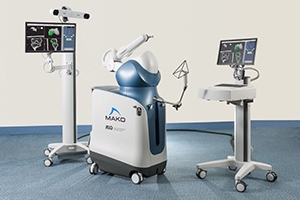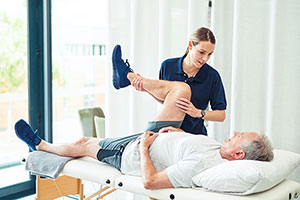Hip pain isn’t an uncommon experience. Events that impede the smooth motion of the ball (femur) inside the socket (pelvis), such as a sports injury, wear and tear due to overuse, pregnancy, or an underlying condition, can all cause hip pain. In some cases, the pain can arise due to misalignment, causing the joint to have difficulty gliding as intended and limiting its range of motion.
Are My Hips Misaligned? Hip Misalignment Symptoms to Watch Out For
Are my hips misaligned? is typically not the first question patients ask when dealing with hip pain. As one of the body's largest and most complex joints, any disturbance can contribute to slight discomfort, making it challenging to detect alignment issues.
Hip alignment issues are diagnosed when hip and back issues are accompanied by one or more of the following symptoms:
- Knee, ankle, or foot pain
- Sciatica
- Tightness or restrictions in the movement of the hips
- Uneven shoulders
- Uneven gait (manner of walking)
Many of the above hip misalignment symptoms are also associated with other conditions. Therefore, for a more accurate diagnosis, you should seek professional help from a good orthopedic specialist.
What Does It Mean When Your Hips Are Out of Alignment?
What does it mean when your hips are out of alignment? First, the feeling of being “out of place” associated with misalignment doesn’t mean that the hip is out of place. An out-of-place hip would mean it’s dislocated, which is quite painful and may require a trip to the emergency room.
Secondly, the pain associated with hip misalignment may be one-sided lower back pain near the SI joint, which gives the perception of a locked back, limited motion, or a general feeling of discomfort.
In biomechanics, a misaligned hip can mean that it has moved away from a centered position. It may be rotated forward or backward, favoring one side. This action forces the spine as well as the lower limb to compensate. This results in tilting the spine, which may make the legs appear uneven.
How Does Hip Misalignment Affect Me?
As mentioned previously, hip misalignment forces the spine and lower limbs to compensate. Your shoulders and upper back are connected to your pelvis through the spine, which means they can also be affected. These result in:
- Uneven shoulders, with the shoulder above the lower hip appearing higher
- Shoulder blades may stick out on the side with the lower hip
- Uneven leg length, with the leg on the higher hip appearing shorter
- Rib cage may appear more prominent on one side as a result of severe scoliosis
What Causes Hips To Go Out of Alignment?
Hip misalignment can be caused by several factors. These include:
Scoliosis
Scoliosis is a spinal deformity that results in the abnormal lateral curvature of the spine. It is more commonly diagnosed among children and teenagers because it occurs around the growth spurt. However, as an adult, if you have not been diagnosed with scoliosis, it is most likely not the cause of misalignment in your hip.
Anatomical Leg Length Discrepancy
The anatomical or structural discrepancy in limb length is the physical shortening of a person’s lower limbs. They can be congenital but can also be acquired due to trauma to the hip, orthopedic generative disease, fractures, or complications due to orthopedic surgery.
Having legs at different lengths may cause the hips to become misaligned. In most cases, this can be corrected with the help of a wedge placed in one shoe as a simple corrective measure. But in more severe cases, surgery may be required.
Hip misalignment as a result of an anatomical leg length discrepancy takes years to develop and would normally begin around the adolescent years. If pain due to misalignment is a relatively recent discovery, it’s highly likely not a structural issue but a functional one.
Functional Leg Length Discrepancy
Functional, non-structural leg length discrepancy is a condition associated with an observed unilateral asymmetry in the lower extremities without the actual shortening of the limbs. Essentially, your legs have the same length but are misaligned due to several factors that alter lower limb mechanics, such as muscle weakness or joint contracture. Common causes of hip misalignment as a result of a functional leg length discrepancy include:
- Uneven pressure on the pelvis as a result of carrying a heavy load on one shoulder
- Wearing shoes that provide uneven support
- Constantly leaning or standing on one leg
- Bad seating posture
What Treatment Options are Available?
Stretching helps loosens the muscles around the pelvis, which can help alleviate pain and fix minor issues that contribute to misalignment. Hip stretches like the 90/90 stretch, the side plank, and the superman are all stretches you can do at home to improve symptoms. But note that these stretches can create a slight discomfort in the affected area. It’s best to stop immediately if you experience pain during these exercises, as pain is not a good sign.
While some stretches can help, it’s not recommended to perform extreme stretches in an attempt to “pop it into place.” Without a solid understanding of what is happening, managing the problem alone may aggravate the injury and create an even bigger problem. This is why you must seek professional help from an excellent orthopedic specialist.
Seek Expert Orthopedic Care at the American Hip Institute
If you are experiencing hip misalignment issues, seek the expert advice of a licensed orthopedic specialist to determine the root cause. Understanding the main reason for misalignment ensures that the proper corrective action is performed, which is instrumental in your quick recovery.
The American Hip Institute provides industry-leading hip treatment solutions to restore the alignment of the pelvis. After determining the extent of your injuries, our orthopedic specialists will determine the best course of action and help you develop a personalized recovery plan. Contact us today to schedule your appointment.




